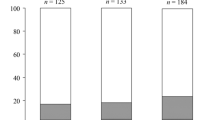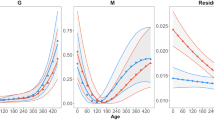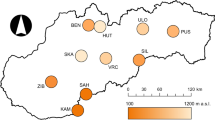Abstract
Differences in population growth among four variation types of the ladybird beetle, Harmonia axyridis Pallas, namely succinea, conspicua, spectabilis and aulica, were investigated using various growth parameters. The variation types showed three growth patterns from the intrinsic growth rates (rm), with rates of 0.093–0.099 (for conspicua and aulica), 0.073 (for succinea) and 0.040 (for spectabilis). The growth rates of these patterns were realised in different ways. Spectabilis differed from the other three types in the age and per cent distribution of the specific period to the rm values.
Résumé
Des différences dans la croissance de population parmi 4 types de variétés chez la coccinelle, Harmonia axyridis Pallas, a savoir succinea, conspicua, specialis et aulica ont été étudiées au moyen de divers paramètres de croissance. Les types de variétés ont montré 3 formes de croissance du point de vue taux de croissance intrinsèque (rm), la 1ère avec un taux de 0,093–0,099 chez conspicua et aulica, une autre avec un taux de 0,073 chez succinea et l’autre de 0,040 pour spectabilis. Les taux de croissance chez ces formes ont été accomplis de diverses manières. En outre, spectabilis a différé des trois autres formes sur la distribution d’âge et le pourcentage de la période spécifique par rapport aux valeurs de rm.
Similar content being viewed by others
References
Barker J. S. F., Starmer W. T. and MacIntyre R. J. (1990) Ecological and Evolutionary Genetics of Drosophila. Plenum Press, New York.
Birch L. C. (1948) The intrinsic rate of natural increase of an insect population. J. Anim. Ecol. 17, 15–26.
Clarke C.B. (1979) The evolution of genetic diversity. Proc. R. Soc. Lond B. 205, 453–474.
Dobzhansky T. (1951) Genetics and the Origin of Species, 3rd ed. Columbia University Press, New York.
Ford E. B. (1971) Ecological Genetics, 3rd ed. Chapman & Hall, London.
Geng Z. C. and Tan J. Z. (1980) On some genetic problems in the Asiatic ladybird beetle, Harmonia axyridis Pallas. Nature Journal, China 3, 512–518.
Kuang R. P. and Fleming R. (1992) Validation and analyses of the simple method for determining rm of aphids and mites. Zool. Res. China 13, 37–46.
Kuang R. P. and Smith S. M. (1993) Application of Wyatt-White method to calculating intrinsic rates of increase for hymenopterous parasitoids. Zool. Res. China 14, 208–214.
Pimentel D. (1961) Animal population regulation by the genetic feedback mechanism. American Naturalist Vol. XCV, 65–79.
Pimentel D. (1968) Population regulation and genetic feedback. Science 159, 1432–1437.
Shi L. M. (1990) Genetic diversity and its conservation. In Proceedings of the Symposium on Biological Diversity (Edited by Wang Song and Du xue-Hao), pp. 73–82. Bureau of Biosciences and Biotechnology, Chinese Academy of Sciences, Beijing, 1990.
Wyatt I. J. and White P. F. (1977) Simple estimation of intrinsic increase rates for aphids and tetranychid mites. J. Appl. Ecol. 14, 757–766.
Author information
Authors and Affiliations
Rights and permissions
About this article
Cite this article
Kuang, R.P., Xiao, N.N. Growth Patterns of the Ladybird (Harmonia Axyridis Pallas) Relative to Variations in Population Genetics. Int J Trop Insect Sci 16, 35–38 (1995). https://doi.org/10.1017/S1742758400018294
Accepted:
Published:
Issue Date:
DOI: https://doi.org/10.1017/S1742758400018294




